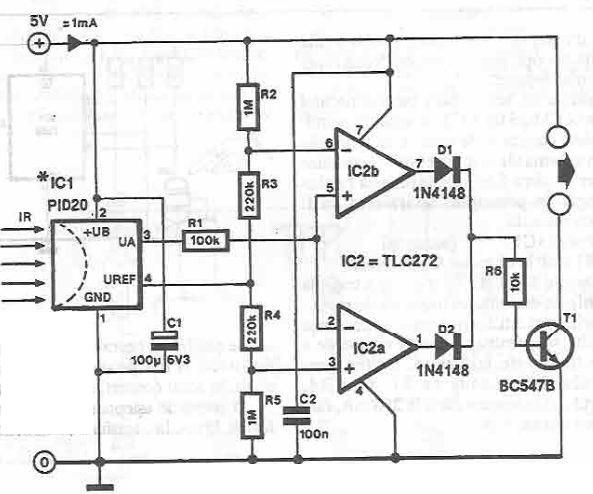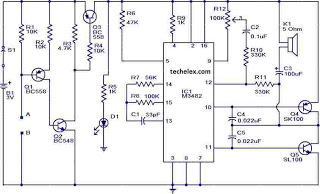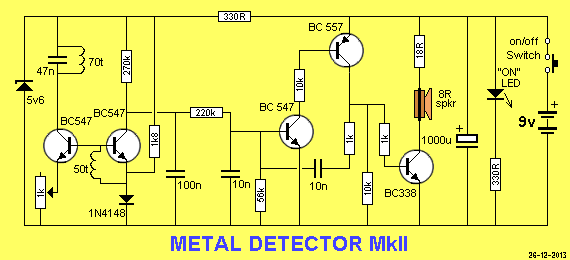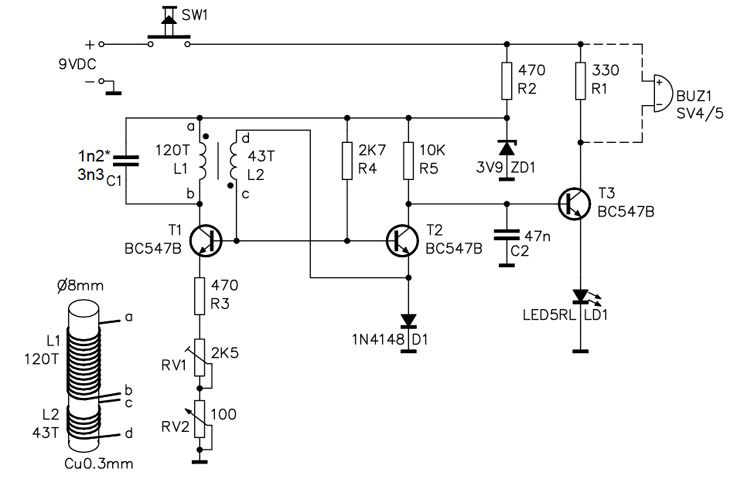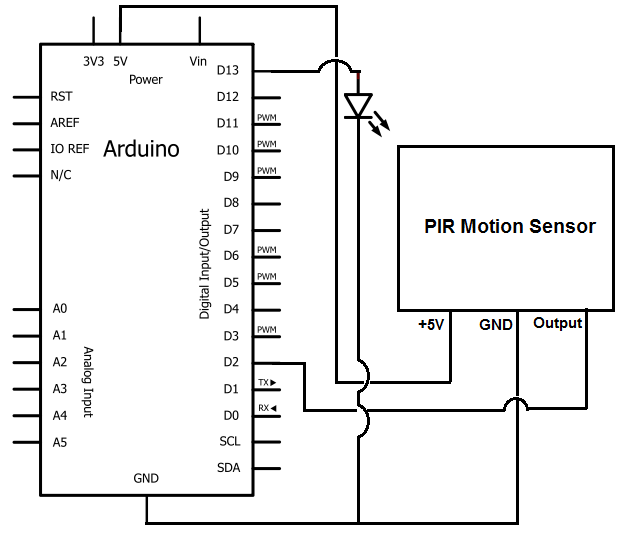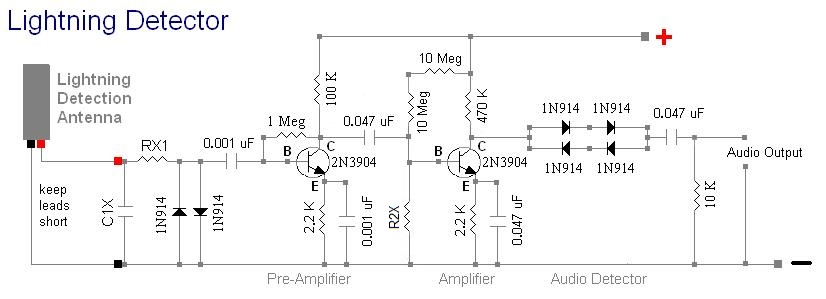
Hi-fi AM detector
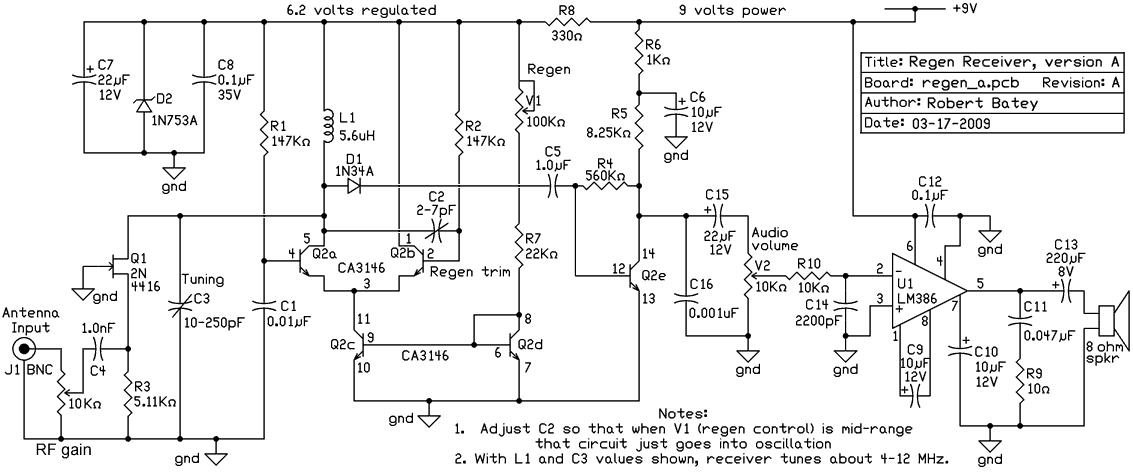
A modification to David Knight's linear detector circuit was developed to create a high-fidelity AM receiver requiring an ultra-linear AM detector. The revised circuit eliminates the meter circuit and many bypass capacitors, resulting in a design with a finite quiescent current at the output terminal while maintaining high linearity. The input waveform is represented by the lower trace, with the output depicted in the upper trace. The adjustment of resistor R2 allows for the input signal to achieve the desired signal swing. In the final application, capacitor C4 will be replaced with a superior filtering system and a 10 kHz notch filter. This modification is considered superior to a germanium diode detector. The circuit has been simulated for 455 kHz, and it is anticipated to function effectively at frequencies exceeding 5 MHz. The schematic includes a complete detector with a 10 kHz notch filter tailored for the American band plan, which mitigates the adjacent-channel carrier heterodyne whistle, particularly problematic during nighttime reception due to sky-wave propagation. The circuit can also be retuned for the European 9 kHz channel spacing. The advantage of Knight's linearization method is its compatibility with a low-voltage single supply, operating effectively at 6 V while providing a buffered output. The concept of "Hi-Fi AM" emerged unexpectedly, demonstrating performance that can rival FM in certain scenarios, particularly in areas of Idaho where FM is not available. The input impedance is sufficiently high, allowing direct connection to the notch filter without additional buffering. The supply voltage can range from 5 V to 12 V without adverse effects. The voltage divider formed by resistors R5 and R6 governs the circuit's quality factor (Q), while resistor R3 adjusts the center frequency, potentially interacting with Q. R5 and R6 can be implemented using a 1 kΩ resistor in series with a 200Ω trimmer potentiometer, and R3 can similarly be configured. This setup facilitates fine-tuning to achieve an 18-20 dB notch and a center frequency of 10 kHz. A challenge in AM broadcast reception with a relatively wide intermediate frequency (IF) bandwidth is the transmission of full carrier signals by stations, leading to potential reception of a 10 kHz "whistle" when conditions are favorable, especially at night. This high-pitched noise is often perceptible to most individuals, while the next channel is 20 kHz away, typically beyond the hearing range of adults. The low-pass filter (LPF) in the detector also attenuates this noise. A bridged-T filter design utilizing an op-amp is proposed as an effective "whistle" filter for the medium-wave band, ensuring minimal degradation of audio frequency response. The filter employs bootstrapping with feedback from a unity follower, although an emitter follower may also be considered; however, the 383 kΩ resistor necessitates a high input impedance for the buffer amplifier. The voltage divider comprising R5 and R6 can enhance Q by decreasing R5 and increasing R6. Caution is required, as increasing Q can reduce notch depth. The filter design is inspired by National Semiconductor Linear Brief 5, which details a twin-T notch filter with bootstrapping to enhance Q. This technique has been adapted for use in a bridged-T circuit. Additionally, a Hi-Fi AM superheterodyne receiver utilizing the discussed linear detector has been designed, fitting onto a compact printed circuit board (PCB). The linear detector occupies the foreground of the PCB, while a TO220 package containing an LM317 voltage regulator provides the 6 V power supply. The front-end circuit employs the NXP/Philips NE602 double-balanced mixer chip, or alternatively, the SA612, which is a more economical option. It is noted that capacitors C5 and C6 were not included in the final assembly. The NE602/SA612 offers various advantages for this application.A modification to David Knight`s linear detector circuit. I wanted to build a "hi-fidelity" AM receiver and needed an ultra-linear AM detector for it. Here is the circuit I came up with: Note that I eliminated the meter circuit, and removed a lot of the bypass caps. I now have a circuit that has a finite quiescent current at the output te rminal but is extremely linear as you can see. The input waveform is the lower trace, upper trace being the output. My strategy is to adjust R2 so that the input signal gives the proper signal swing. In the application I will replace C4 with a better filtering system and 10 kHz. notch filter. This should do nicely and is far superior to a germanium diode detector. The simulation shown is for 455 kHz, but (subject to practical confirmation) it appears that the circuit will work to well over 5 MHz. Below is the schematic of the complete detector with 10 kHz notch filter (for the American band plan).
The filter gets rid of the adjacent-channel carrier heterodyne whistle, which can be bad at night when the sky-wave comes in. It can be re-tuned for the European 9 kHz channel spacing as well. One reason for using Dave Knight`s method of linearizing the detector is that it fits well with a low voltage single supply.
As you can see I powered my 455 kHz. detector from 6 V and it has a buffered output. I discovered "Hi-Fi AM" quite by accident too. It can rival FM to some extent and some of the venues on AM here in Idaho are not available on FM. The input Z is high enough so that the detector circuit can drive directly into the notch filter with no additional buffering. Supply voltage for this circuit can vary between 5 V and 12 V with no ill effects. Voltage divider R5/R6 controls the circuit Q, R3 controls the center frequency but may interact with the Q (second order).
R5/R6 can be realized with a 1 k resistor in series with a 200 ohm trim pot. R3 can be realized with another 1 k resistor in series with a 200 ohm trim pot connected as a rheostat. This will allow trimming of the circuit to match the 18-20 dB notch and center frequency of 10 kHz. One of the problems with AM broadcast reception using a relatively wide IF bandwidth is that the stations transmit full carrier and the channel spacing is only 10 kHz (in America, 9 kHz in Europe).
Thus it is possible to receive a 10 kHz "whistle" when reception is good (such as at night). This high pitched noise is easy to hear for most people. The next channel is 20 kHz. away, which is out of typical adult hearing range, and the LPF in the detector attenuates it as well. Here is a good "whistle" filter for the MW band that doesn`t degrade the audio frequency response. Note that it is a bridged-T design and uses an op-amp. The filter is bootstrapped with feedback from the unity follower. It is possible that an emitter follower could be used as well for this, but the 383 k resistor requires a very high input impedance for the buffer amplifier.
The voltage divider formed by R5 and R6 will increase the Q as R5 is lowered and R6 is raised in value. Care must be used, however, as the notch depth is affected, and there is less notch depth as the Q increases.
The idea for the filter comes from National Semiconductor Linear Brief 5. This shows a full twin-T notch filter bootstrapped to improve the Q. I found that the same technique could be used to bootstrap a bridged T circuit. Here is a Hi-Fi AM superhet receiver using the linear detector discussed above. The whole thing fits on a small PC board pictured right. The linear detector is on the part of the PC board in the foreground, and the TO220 package to the left of it is an LM317 voltage regulator for the 6 V power rail. The front end circuit is shown below. It uses the NXP / Philips NE602 double-balanced mixer chip; or, as here, the SA612, which is a lower cost version.
C5 and C6 were NOT fitted in the final build. The NE602 / SA612 has diffe 🔗 External reference
The filter gets rid of the adjacent-channel carrier heterodyne whistle, which can be bad at night when the sky-wave comes in. It can be re-tuned for the European 9 kHz channel spacing as well. One reason for using Dave Knight`s method of linearizing the detector is that it fits well with a low voltage single supply.
As you can see I powered my 455 kHz. detector from 6 V and it has a buffered output. I discovered "Hi-Fi AM" quite by accident too. It can rival FM to some extent and some of the venues on AM here in Idaho are not available on FM. The input Z is high enough so that the detector circuit can drive directly into the notch filter with no additional buffering. Supply voltage for this circuit can vary between 5 V and 12 V with no ill effects. Voltage divider R5/R6 controls the circuit Q, R3 controls the center frequency but may interact with the Q (second order).
R5/R6 can be realized with a 1 k resistor in series with a 200 ohm trim pot. R3 can be realized with another 1 k resistor in series with a 200 ohm trim pot connected as a rheostat. This will allow trimming of the circuit to match the 18-20 dB notch and center frequency of 10 kHz. One of the problems with AM broadcast reception using a relatively wide IF bandwidth is that the stations transmit full carrier and the channel spacing is only 10 kHz (in America, 9 kHz in Europe).
Thus it is possible to receive a 10 kHz "whistle" when reception is good (such as at night). This high pitched noise is easy to hear for most people. The next channel is 20 kHz. away, which is out of typical adult hearing range, and the LPF in the detector attenuates it as well. Here is a good "whistle" filter for the MW band that doesn`t degrade the audio frequency response. Note that it is a bridged-T design and uses an op-amp. The filter is bootstrapped with feedback from the unity follower. It is possible that an emitter follower could be used as well for this, but the 383 k resistor requires a very high input impedance for the buffer amplifier.
The voltage divider formed by R5 and R6 will increase the Q as R5 is lowered and R6 is raised in value. Care must be used, however, as the notch depth is affected, and there is less notch depth as the Q increases.
The idea for the filter comes from National Semiconductor Linear Brief 5. This shows a full twin-T notch filter bootstrapped to improve the Q. I found that the same technique could be used to bootstrap a bridged T circuit. Here is a Hi-Fi AM superhet receiver using the linear detector discussed above. The whole thing fits on a small PC board pictured right. The linear detector is on the part of the PC board in the foreground, and the TO220 package to the left of it is an LM317 voltage regulator for the 6 V power rail. The front end circuit is shown below. It uses the NXP / Philips NE602 double-balanced mixer chip; or, as here, the SA612, which is a lower cost version.
C5 and C6 were NOT fitted in the final build. The NE602 / SA612 has diffe 🔗 External reference
